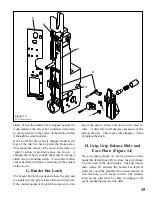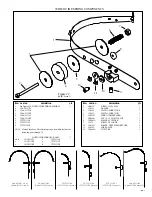
12
A. Insufficient or Excessive
Compression
Proper compression of work between the clincher
and the bender bars is necessary so that the stitch
penetrates the work material and clinches correctly.
To test for compression, drive several stitches into
sample work material. With proper compression,
stitches hold the work together firmly and the
clinched legs do not overlap. In the following in-
stances, either one or all of the conditions may
exist: with insufficient compression, stitch legs over-
lap, crown of the stitch is fractured, and the work
mutilated. The method for obtaining proper wire
draw and compression is detailed in the Operation
Section on Page 7 under the heading, "Changing Work
Thickness".
B. Clincher (Figure 8)
The purpose of the clincher is to turn the legs of the
stitch back after they have penetrated the work ma-
terial. There are two types of clinchers:
1. Solid (stationary) Type-makes a loop clinch.
2. Activated (moving) Type-makes a flat clinch.
With the Solid (stationary) Type clincher, the legs
of the stitch must strike the clincher at the same
time and with equal spacing from the outside edges
of the grooves. The grooves in the clincher should
be smooth. Any interference (particularly worn or
pitted grooves), which change the original radii,
will cause the stitch legs to buckle and/or the cor-
ners of the crown to fracture.
With the Activated (moving) Type clincher, the
stitch legs must enter the clincher at the same time
and with equal spacing from each side. When the
CAUTION
Turn Power OFF Before
making Any Adjustments
stitch legs have penetrated the work material, the
moving clinchers are raised to bend the legs to-
wards each other and up flat against the work. The
clincher points must bend both legs of the stitch
against the work with the same force. Clincher
points must always move freely and not bind. Dirt,
wire chips, etc. will cause the points to bind.
The clincher points are in a retracted position in the
clincher box until the stitch legs penetrate the work
material. After the legs penetrate, the clincher points
move upward to give a neat, flat clinch against the
bottom surface of the work material. If the clincher
points remain in the up position, the legs of the
next stitch cannot penetrate the work material, caus-
ing the stitch legs to buckle and/or the corners of
the crown to fracture. Examine the clincher points,
clincher slide for possible binding. Clean and oil.
If clincher points rise to high, they fracture the stitch
legs and/or mar the work. If the points do not rise
high enough, the legs will not clinch flat. Adjust
the height of the clincher points. For most work
the clincher points should rise to be level with the
top of the clincher housing.
ACTIVATED
SOLID
STITCH
STITCH
(SK852F)
Figure 8















































